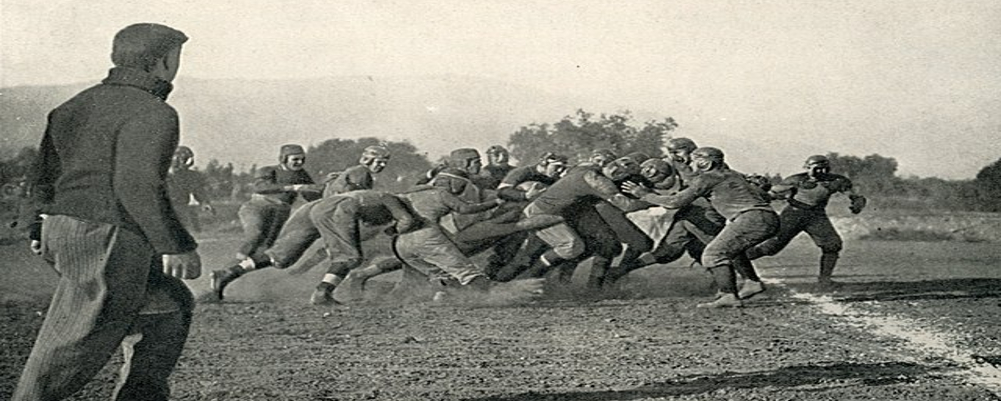Transcription of Davey Obrien and Standing Tall with Timothy Brown
This is Darin Hayes of PigskinDispatch.com. Welcome once again to The Pig Pen, your portal to positive football history.
And as we try to do every Tuesday, we like to go on a little archaeological expedition. We go to the man on the website Football Archaeology, Timothy Brown. Tim, welcome back to The Pig Pen.
Hey there. Thank you. Appreciate you having me again.
Looking forward to digging into a few things tonight. Digging is right. We were, you know, interested.
We were talking about this before we came on about one of your tidbits. You know, some of these, they're all stimulating, but some really catch my eye, and I'd love to hear a little bit more about them. This one came from later in October, and it's called Standing Call for the Heisman on October 23rd on FootballArchaeology.com. I was hoping maybe you could say a few words about that subject matter.
Yeah, you know, happy to. So, the Standing Call is, you know, basically about a guy named Davy O'Brien, who was a Heisman Trophy winner in 1938. But he was 5'7".
And, you know, so we all know, we all went to high school or grade school or whatever with some guy who was too short, but he was a heck of an athlete. And, you know, just the guy was a stud. But eventually, he kind of met his limits athletically, you know, in terms of competing against, you know, bigger players.
Even in high school, a lot of guys that size can get away with things. And here and there, we've got an NBA or an NFL player who does it. But back then, it was a little bit more common, you know.
And so, Davy O'Brien was, you know, like I said, 5'7", grew up in Dallas. And he succeeded Sammy Baugh as the quarterback or the center of the Dutch Meyers TPU spread office. So, you know, I mean, we like to think the spread is this brand new, shiny thing that all these smart, you know, modern people created.
But back in the 30s, in the late 30s, Dutch Meyers was running an offense that had two basic formations. One was had a single back, the double wing and two double split ends. You know, so just think about that.
A single back, double wings, and two split ends, right? So that looks like a lot of people's spreads nowadays. He also ran, he didn't call it this, but he ran an empty formation with trips on one side, you know, and split on the other. So, and he ran the ball, it's a lot.
So, I mean, run it especially out of the one-back formation. So, I mean, it's just the idea that these guys, TCU, were doing things well before anybody else in terms of just bringing modern spread horizontal concepts to football. So, you get this guy, Davey O'Brien, who takes over for Sammy Ball, who's got it, and, you know, it's back in single platoon football.
So, O'Brien played both ways. He wasn't just this little, you know, a dinky quarterback that, you know, just ran out and was protected against being tackled hard and stuff like that. You know, he was a player, he's a blocking back, he punted, you know, he was their primary punter.
And so, I'm going to say this next thing with a little bit of caution. As a senior, he set the passing yardage in a season record, NCAA record. He also set the combined rushing and passing by an individual in a season.
Now, that was a 1938 season, and the NCAA only started tracking statistics in 1937. So, you know, it wasn't, yeah, okay, you know, but nevertheless, I mean, the point really is that what he was doing so far ahead of almost anybody else, right? And so, and just one little side note to the statistics thing. The statistics weren't, you know, it was like the NCAA did this.
It was a separate guy named Herman Homer who created this entity called the American Football Statistical Bureau, and then in 22 years, they sold it to the NCAA. And so, all of the football records of the NCAA were actually, for the first 22 years, compiled by a separate company. You know, so his company started in 37.
And so, if you look at any NCAA record, they start in 1937, you know, from this guy's records. Anyways, Davey O'Brien was a stud. So, he finishes his senior year, winning a national championship.
He's the Maxwell and Heisman Trophy winner. He then gets drafted by the NFL; the Giants take him number four in the 39 draft. He leads the NFL in passing yardage as a rookie, though they only won one game, and comes back as a second-year player.
Again, has a great season. They only win one game. And then he says, I'm done.
And he quits pro football and becomes an FBI agent. And he does that for about 10 years and goes into various business adventures, you know. So, it's just kind of an interesting thing.
You know, there are very few NFL players who leave today to become FBI agents, right? Especially when you just led the league in passing. But, you know, different times, different places. Different pay scales.
Yeah, different pay scale, you know. Well, here's another thing about it. To that point, he was the fourth Heisman Trophy winner, but he was the first one to sign with the NFL.
The first three didn't even bother. Oh, that's right. Yeah.
You know, they were coming from the University of Chicago and two guys from Yale, and they were like, hey, I don't need this NFL thing. I've got better, you know, business opportunities. And so, you know, none of the first, you know, neither none, whatever of the first three played in the NFL.
Yeah, you really have to go back and really admire people that play professional football, especially those first, like, five or six decades, because they really did it for the love of the game and the love of the competition. They weren't getting rich by doing it. Most, you know, I think almost all of them had to have a regular job in the offseason and things like that.
And it's just an amazing thing to think about where today, you know, that's their whole life. And, you know, they're, they're set for life after playing a couple of years. And yeah, I would say, you know, they made significant money compared to the average worker, right? And for some of them, it was just like today.
I mean, I get into arguments. I got into a recent argument or spat with some CFL fans about the talent levels between the NFL and CFL. And, you know, the CFL has tremendous players. I mean, they're gifted athletes, but they're, in my mind, just not anywhere near NFL caliber.
I mean, yeah, some of them are bottom-end NFL players, and that's fine. But, the point is that even in the CFL, they can make more money playing as a 24, 25-year-old young man in the CFL compared to getting out of school and whatever, becoming an underwriter or, you know, whatever it is you do when you leave school, right? Now, if they were chemical engineering majors or something, yeah, they can make more money doing that. But, you know, not many of those are playing football.
Yeah. Yeah. I think that that's a pretty good parallel.
You know, I didn't think that maybe not even the CFL, but maybe some of these, these other leagues that are coming up, you know, like the XFL and the spring league and now, now the USFL, some of those, you know, those guys aren't making much at all compared to their peers in the bigger leagues, you know, like the NFL and the CFL, but they're doing enough to make a living and get by. And you know, hopeful their hope is to advance into the NFL. And I'm sure that's probably the goal.
And I think that's it. It's the hope it's keeping the hope alive. Right.
And then there are kids who are probably more like D3 sort of kids, but you know, there are a decent number of American kids now heading over to Europe and playing. And, but it's more of a cultural experience, and they're not making big money. I mean, literally, they're making, I know one kid who played in the NF or in Europe last year, making like 800, a thousand bucks a game, but he got into an NFL camp this year, you know, and got cut, but you know, he made a camp.
And so, you know but, but I think for guys like that, it's more like, yeah, you got a chance to play in Austria or live in Finland for six months or something, you know, it's, it's a life experience rather than money, money grab, you know? Yeah. Yeah. It's definitely an interesting lifestyle.
And when you can do the thing you love and travel, Hey, why, why not do it when you're a young person? Any day, any day. Right. Good for them.
Good for them. I mean, I don't care what level you're playing, playing, if you're still taking a shot at it, have at it, you know? Absolutely. Yeah.
So good for you. Yeah. Love to hear that.
All right. Well, Tim, why don't we take this opportunity right now to, you know, just like this was a tidbit on Davey O'Brien, you have some very interesting things coming out each and every day, sometimes multiples in a day. And why don't you share with folks how they can get on your list to get this information? Yeah.
So, you know, my site is footballarchaeology.com. You can go on there and subscribe. And what that means is you'll get an email at seven o'clock every day. And then, some other days, you'll get more than one, but basically, you'll get at least a daily email that provides some information.
And if, if not there, then you can I mean, you can always visit the site just, you know, randomly, but you can also follow me on Twitter at football archaeology. And so whichever, however you consume information, however you prefer to view it, have at it. I'm more than happy to have people check it out.
All right. Well, Tim Brown, football archaeology. Thank you once again for joining us this week and talking about some more great football history and some of these great things from the past that may be overlooked, but we're glad that you're researching them and bringing them to our attention.
And we'd love to talk to you again next week. Very good. Look forward to it, sir.
Transcribed by TurboScribe.ai.



